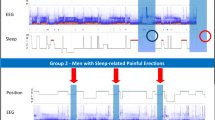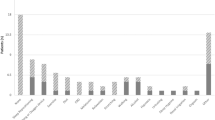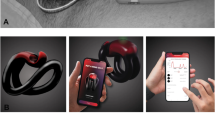Abstract
We questioned the need for more than one RigiScan recording for accurate assessment of sleep-associated penile erections and determine the necessity of consecutive nightly recordings for valid evaluation of sleep-associated erections. Men complaining of erectile dysfunction (ED) and referred to RigiScan evaluation for the first time participated. Recordings were performed at the patient's home during two consecutive nights, and data on test time, number of erections, erection duration, minimal and maximal base and tip tumescence and rigidity were retrieved for both nights. Normal erectile function was defined with the recording of at least one erection (70 out of 100% tip rigidity lasting for at least 10 min during either night). The main outcome measures were RigiScan recordings. Group 1 consisted of 29 men (mean age 42.4±13.8 years, range 22–71) who had normal erections, all during the first night. Group 2 consisted of 26 men (mean age 48.6±13.5 years, range 25–70) who failed to fulfill both criteria for normal erection. In Group 2, only the values for penile base rigidity and erection duration were normal during the first night: the parameters of maximal base tumescence, tip rigidity, number of effective erections and duration of effective erections that were impaired during the first night were significantly worse (P<0.01) during the second night. The required information for the diagnosis of psychogenic ED was obtained during the first night in >50% of the participants. Men with normal erections during the first night can be spared the inconvenience and cost of re-testing. Consecutive night recording should be reserved for patients whose recorded data during the first night did not fulfill the criteria for normal erection.
This is a preview of subscription content, access via your institution
Access options
Subscribe to this journal
Receive 8 print issues and online access
$259.00 per year
only $32.38 per issue
Buy this article
- Purchase on Springer Link
- Instant access to full article PDF
Prices may be subject to local taxes which are calculated during checkout
Similar content being viewed by others
References
The process of care model for evaluation and treatment of erectile dysfunction. The Process of Care Consensus Panel. Int J Impot Res 1999; 11: 59–70 (discussion 70–74).
Karacan I, Williams RL, Thornby JI, Salis PJ . Sleep-related penile tumescence as a function of age. Am J Psychiatry 1975; 132: 932–937.
Bradley WE, Timm GW, Gallagher JM, Johnson BK . New method for continuous measurement of nocturnal penile tumescence and rigidity. Urology 1985; 26: 4–9.
Hatzichristou DG, Hatzimouratidis K, Ioannides E, Yannakoyorgos K, Dimitriadis G, Kalinderis A . Nocturnal penile tumescence and rigidity monitoring in young potent volunteers: reproducibility, evaluation criteria and the effect of sexual intercourse. J Urol 1998; 159: 1921–1926.
Rosen RC, Riley A, Wagner G, Osterloh IH, Kirkpatrick J, Mishra A . The international index of erectile function (IIEF): a multidimensional scale for assessment of erectile dysfunction. Urology 1997; 49: 822–830.
Chen J, Greenstein A, Sofer M, Matzkin H . Rigiscan versus snap gauge band measurements – is the extra cost worthwhile? Int J Impot Res 1999; 11: 315–318.
Helgason AR, Arver S, Adolfsson J, Dickman P, Granath F, Steineck G . ‘Potency’: the validation of information from a self-administered questionnaire using objective measurements of night-time erections and test-retest reliability. Br J Urol 1998; 81: 135–141.
Montorsi F, Maga T, Strambi LF, Salonia A, Barbieri L, Scattoni V et al. Sildenafil taken at bedtime significantly increases nocturnal erections: results of a placebo-controlled study. Urology 2000; 56: 906–911.
Greenstein A, Chen J, Salonia A, Sofer M, Matzkin H, Montorsi F . Does sildenafil enhance quality of nocturnal erections in healthy young men? A NPT-RigiScanTM study. J Sex Med 2004; 1: 314–317.
Gingell C, Sultana SR, Wulff MB, Gepi-Attee S . Duration of action of sildenafil citrate in men with erectile dysfunction. J Sex Med 2004; 1: 179–184.
Montorsi F, Oettel M . Testosterone and sleep-related erections: an overview. J Sex Med 2005; 2: 771–784.
Mann K, Pankok J, Connemann B, Röschke J . Temporal relationship between nocturnal erections and rapid eye movement episodes in healthy men. Neuropsychobiology 2003; 47: 109–114.
Author information
Authors and Affiliations
Corresponding author
Rights and permissions
About this article
Cite this article
Greenstein, A., Mabjeesh, N., Sofer, M. et al. Are consecutive nightly recordings required for valid evaluation of sleep-associated erections?. Int J Impot Res 19, 196–199 (2007). https://doi.org/10.1038/sj.ijir.3901512
Received:
Accepted:
Published:
Issue Date:
DOI: https://doi.org/10.1038/sj.ijir.3901512
Keywords
This article is cited by
-
Association between sleep quality and nocturnal erection monitor by RigiScan in erectile dysfunction patients: a prospective study using fitbit charge 2
Basic and Clinical Andrology (2023)
-
Sexual asthenia: Tradamixina versus Tadalafil 5 mg daily
BMC Surgery (2012)
-
Testosterone deficiency causes penile fibrosis and organic erectile dysfunction in aging men. Evaluating association among Age, TDS and ED
BMC Surgery (2012)



